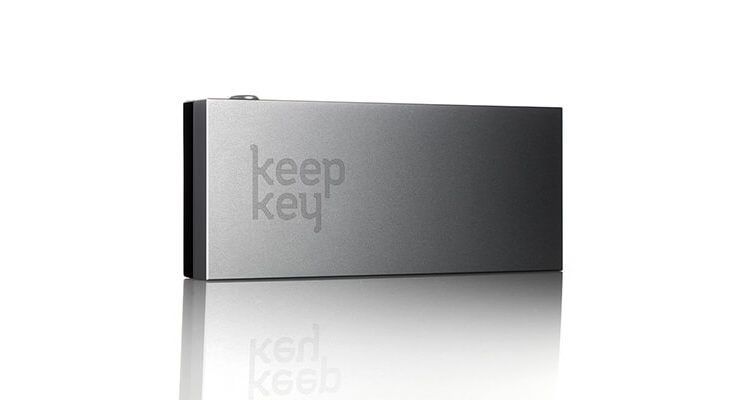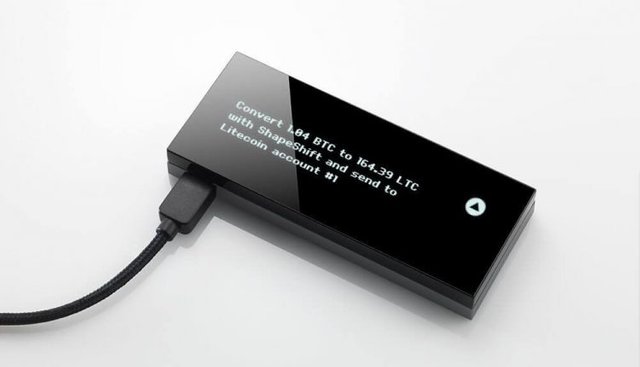KeepKey Hardware Wallet Review

Before we start with the KeepKey review we’ll go over briefly what a hardware wallet is.
Hardware wallets are without a doubt the best way to store your cryptocurrency. They provide a form of cold storage that allows you to keep your Bitcoin or altcoins safe for long periods of time. They allow you to send and receive crypto from any computer, even if it’s infected with malware. They do this by securing your private keys offline on the device. In addition to this they generally have a small screen that is used to sign transactions. All this means that even if someone was to gain access to any of your accounts or your computer, they would also need the hardware wallet to complete any transaction. Most hardware wallets also include a pin number to help secure the device if it ever falls into the wrong hands.
Overall, hardwares wallets are a must if you’re looking to store cryptocurrency long term. We’ll take a look at the KeepKey, a competitor to the Ledger Nano S and the Trezor, and tell you everything you need to know about buying a hardware wallet.
What’s included with the KeepKey?
The KeepKey comes in a sleek, tamper-proof box. Inside you’ll find:
- The KeepKey hardware wallet.
- A small pouch.
- KeepKey recovery sentence card.
- Warranty booklet.
- Quick start guide.
<h2Features
The KeepKey has all the standard features of a hardware wallet. It’s main purpose being a cold storage option for your cryptocurrency. It’s compatible with Windows, Mac or Linux and uses a Google Chrome extension when to connect to a computer.
One of the best features of the KeepKey that neither the Ledger Nano S or the Trazor has is Shapeshift integration. Shapeshift is a popular platform used to exchange cryptocurrencies with each other. Shapeshift recently announced that they were to acquire KeepKey and integrate their platform with the KeepKey wallet. What this means is that you can easily exchange cryptocurrencies from inside the hardware wallet. There is no need to transfer to a third party outside of the wallet. This can be hugely convenient and will even save you a little if you’re frequently exchanging cryptos.
See how Shapeshift works on the Keepkey in the video below:
User Interface and Design
The first thing you’ll notice is that the KeepKey is relatively large compared to the Ledger and the Trezor. It has one face that is almost entirely a screen. This makes it very easy to see a lot of information directly on the KeepKey. The screen is in keeping with the elegant design of the entire thing but is somewhat reflective which might prove to be occasionally inconvenient. It’s also made mostly from metal and feels much more rugged in the hand compared to the Ledger and Trezor.
The initial set up of the KeepKey is relatively simple, taking just a couple of minutes. First, you’ll have to connect your KeepKey to a computer and it will then be initialised. You will then have to give your KeepKey a label in the software so it can be distinguished.
After this you’ll have to set a pin. The pin on the KeepKey is designed very well. It uses a 3 x 3 square that shows the numbers on the KeepKey but you input the corresponding square on the computer. The order of the numbers on the KeepKey change every time it is activated so keyloggers and other ways of hacking in are protected against.
Once the pin is set up you will see the recovery sentence, a set of 12 words unique to your KeepKey. This is what is needed to recover your cryptocurrencies if you lose your KeepKey. The included recovery sentence card is made for these 12 words. Write them down and keep it safe. This is very important that you keep the recovery words in a safe place and even back them up in case the originals get lost or destroyed as this is the only way that you will be able to recover your money.
From here on you’ll be able to access the main features of the KeepKey. You can send and receive money, exchange using Shapeshift and change pins and wipe your device. Becare with the wiping of the device as this is permanent.
The general user interface of the KeepKey is excellent. The included software on the Chrome extension is easy to use and very clear. The set up is simple and will take you just a few minutes, most of which is going to be writing down your recovery sentence. The large screen definitely helps with ease of use as it’s clear and easy to read.
KeepKey Supported Coins
At the moment the support cryptocurrencies are:
- Bitcoin
- Litecoin
- Dogecoin
- Namecoin
- Testnet
- Ethereum
- Dash
This is nowhere near as good as the other hardware wallets, such as the Ledger Nano S which have many more compatible cryptos.
KeepKey have recently released the first batch of ERC-20 tokens that are to be supported. These are tokens that are built upon the Ethereum ecosystem. They are currently in beta and you can help test them. KeepKey has a relatively unique support for ERC-20 tokens as it doesn’t rely on a third-party wallet. For example the Ledger Nano S requires use of MyEtherWallet. The KeepKey, however can do these directly from the screen and features fully detailed token transactions. Before you sign any token transaction your device will display the specific token name, token amount, destination address and total gas cost. This beta release even has full token functionality to send, receive, transfer, and exchange with the ShapeShift integration.
Read More: The 10 Best Ethereum Wallets

The beta ERC-20 tokens are:
- SALT
- Aragon
- Augur
- BAT
- Civic
- Golem
- Gnosis
- OmiseGO
- District0x
- FunFair
Overall Thoughts
The KeepKey isn’t as popular as the Ledger Nano S or the Trezor hardware wallets. It’s a little more expensive and currently doesn’t support as many coins as either of its competitors. However, the unquie features it offers might be enough to persuade you to get one. The screen is large and clear with an elegant overall design and very simple interface. In addition to this the Shapeshift support is an amazing feature that might be just what you’re looking for. The KeepKey team are constantly updating the software and with the addition of the first ERC-20 tokens they have caught up some ground with the Ledger.
We think if the small screen of the Ledger isn’t big enough for you, or the Shapeshift functionality is something that you would make use of, then the KeepKey is a great hardware wallet and will only get better.
Check the latest price of the KeepKey on Amazon and the KeepKey website.
We recommend buying only from trusted sources, such as Amazon and KeepKey themselves.
For more information and news on the KeepKey and other hardware wallets, follow our Twitter and like our Facebook page.
Cryptos Decoded is a participant in the Amazon Services LLC Associates Program, an affiliate advertising program designed to provide a means for sites to earn advertising fees by linking to Amazon.com and other Amazon websites.